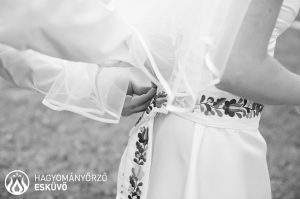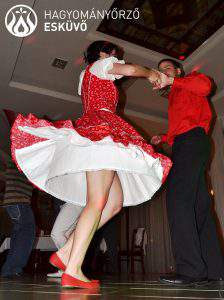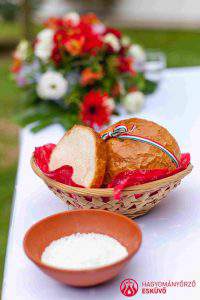The traditional Hungarian wedding

Weddings are events where you can truly learn about the traditions, habits, rites of a nation, because they are centered around them. The Hungarian wedding culture looks back on a rich history, so we thought we’d collect some traditions that characterised weddings back in the day.
Due to the diverse nature of traditions, it would’ve been impossible to collect all of them, so this is a non-exhaustive list. Traditions are also ever-changing, Hungarian weddings are mostly different today, although some rites still form an essential part of the festivities.
Getting ready
Back in the day, it was the task of the best man to invite the guests to the wedding in person, and also to organise the three-day long festivity. According to magyarorszagom.hu, the bride wore a colourful and precisely embroidered dress and a garnished head piece made from wheat, which represented fertility.

On many occasions the whole village took part, which meant a real procession behind a colourfully decorated car that took the bride from her parents’ home to the groom or the church. Sometimes the bride was “kidnapped” and the groom had to “save” her even before the ceremony (“kidnapping” the bride is still a habit at weddings).
Alompar.hu writes that in other places, the accompaniment of the bride and the groom processed to the church separately and gifted the priest some type of dessert or beverage. Thereafter the guests went back to the nuptial house (the house of the parents) to send off the bride. It usually was the best man who said goodbye to the family on behalf of the bride.
After this, the procession went on to the groom’s parents’ house, where the bride’s dower was handed over to the groom. The dower included all immovables and movables the bride had. These things stayed in the ownership of the bride, however, the groom was responsible for handling them.
The wedding ceremony
For a long time, weddings were held in a big tent made from rails and sheets. The nuptial house was decorated and a gate was built from green branches, which represented the renewal of nature and fertility, and it was also believed to be a counter-charm. The branches also played a role in the wedding loaf. The huge loaf was decorated with branches, flowers, fruits and gingerbread. All guests received a piece of loaf, which was usually made by the godparents, because it wasn’t cheap.
Photo: www.facebook.com/HagyományőrzőEsküvőThe arriving bride was welcomed by the parents of the groom with a glass of wine. After she had drunk the wine, she had to throw the glass behind her back. In other places, the couple broke plates on the ground – the more pieces the more successful the marriage. After the compulsory civil ceremony at the court, the simoniac ceremony was held in the nearest church, where guests recited poems, sang songs or recalled funny memories about the couple. Engaged Hungarian couples wore their ring on their left hands and switched to their right hands after the wedding.
Wedding jollities
Guests were welcomed with all types of food flavoured with paprika (it was believed that paprika had magical powers) at the reception. In certain parts of the country, the dinner ended with milk-pap, which was a great occasion to collect “pap money”. The host housewife tied a bandage on one of her hands, held a wooden spoon in the other and went around “crying” as if she had burnt her hand while cooking and needed money for the cure.
After the feast, it was time to dance and sing the night away. Similarly to other East European nations, guests could dance with the bride in exchange for a symbolic amount of money. They either put the money in her dress or threw it into her shoes in the middle of the dance floor. This is called menyasszonytánc (“bride dance”), which is different from menyecsketánc (“cummer dance”), which was the woman’s first dance as a wife. Traditionally she wore a red-white dress or folk costume.

According to tradition, the bride smickered her new husband with some kind of gift or three/seven (lucky numbers) handkerchiefs, while the groom gifted his new wife coins.
According to alompar.hu, the next rite was called kontyolás (“bunning”), during which the maid of honour put the bride’s hair into a bun and added a coif, which symbolised that she had become a wife. Then came the menyasszonyfektetés (“bride laying”), which used to be of legal importance as well. The newlyweds were laid in a separate room, so that the consummation could happen. This was preceded by different rites to ensure fertility. For instance, a kid rolled on the bed to guarantee feracity.

To end the celebrations, the asszonyavatás (“wife inauguration”) was held the next morning (or if the wedding didn’t end at Sunday dawn, the next Sunday morning). The newlyweds dressed up nicely and went to the church, where the new wife could officially take her role. In certain places she even took a loaf with her so that the priest could bless it.
Featured image: www.facebook.com/HagyományőrzőEsküvő
Ce: bm
Source: http://www.magyarorszagom.hu/, http://alompar.hu/





